Hebei
Hebei UK: /ˌhɜːˈbeɪ/[5] or /həˈbeɪ/,[6] UK: /ˈhʌˈbeɪ/[7] (Chinese: ![]() 河北; lit. 'River North'; alternately Hopeh) is a northern province of China. With a population of over 74 million people, Hebei is China's sixth most populous province. Its capital and largest city is Shijiazhuang. The province is 96% Han Chinese, 3% Manchu, 0.8% Hui and 0.3% Mongol. Three Mandarin dialects are spoken in Hebei: Jilu Mandarin, Beijing Mandarin and Jin.
河北; lit. 'River North'; alternately Hopeh) is a northern province of China. With a population of over 74 million people, Hebei is China's sixth most populous province. Its capital and largest city is Shijiazhuang. The province is 96% Han Chinese, 3% Manchu, 0.8% Hui and 0.3% Mongol. Three Mandarin dialects are spoken in Hebei: Jilu Mandarin, Beijing Mandarin and Jin.
Hebei
河北 | |
|---|---|
| Name transcription(s) | |
| • Chinese | 河北省 (Héběi Shěng) |
| • Abbreviation | HE / HEB / 冀 (pinyin: Jì) |
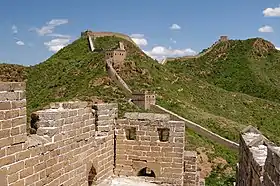 .jpg.webp)  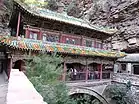  Clockwise: Great Wall at Jinshanling, Chengde Mountain Resort, Puning Temple, Fuqing Temple at Cangyan Mountain, Beidaihe in Qinhuangdao | |
.svg.png.webp) Map showing the location of Hebei Province | |
| Coordinates: 39°18′N 116°42′E | |
| Country | China |
| Named for | 河 hé—"(Yellow) River" 北 běi—"north" "north of the Yellow River" |
| Capital (and largest city) |
Baoding (1729–1913, 1935–1937, 1946–1947, 1949–1958, 1966–1968) Beijing (1928–1930, 1945–1946, 1947–1949) Tianjin (1870–1902, 1913–1928, 1930–1935, 1958–1966) Shijiazhuang (1968–present) |
| Divisions | 11 prefectures, 121 counties, 2207 townships |
| Government | |
| • Type | Province |
| • Body | Hebei Provincial People's Congress |
| • CCP Secretary | Ni Yuefeng |
| • Congress chairman | Wang Dongfeng |
| • Governor | Wang Zhengpu |
| • CPPCC chairman | Ye Dongsong |
| Area | |
| • Total | 188,800 km2 (72,900 sq mi) |
| • Rank | 12th |
| Highest elevation (Mt. Xiaowutai[1]) | 2,882 m (9,455 ft) |
| Population (2020)[2] | |
| • Total | 74,610,235 |
| • Rank | 6th |
| • Density | 400/km2 (1,000/sq mi) |
| • Rank | 11th |
| Demographics | |
| • Ethnic composition | Han: 96% Manchu: 3% Hui: 0.8% Mongol: 0.3% |
| • Languages and dialects | Jilu Mandarin, Beijing Mandarin, Jin |
| ISO 3166 code | CN-HE |
| GDP (2020) | CNY 3.620 trillion USD 524 billion (12th)[3] |
| - per capita | CNY 48,528 USD 7,033 (25th) |
| • growth | |
| HDI (2019) | high · 20th |
| Website | www.hebei.gov.cn (Simplified Chinese) english.hebei.gov.cn (English) |
| Hebei | |||||||||||||||||||||||||||||||||||
|---|---|---|---|---|---|---|---|---|---|---|---|---|---|---|---|---|---|---|---|---|---|---|---|---|---|---|---|---|---|---|---|---|---|---|---|
"Hebei" in Chinese characters | |||||||||||||||||||||||||||||||||||
| Chinese | 河北 | ||||||||||||||||||||||||||||||||||
| Postal | Hopeh | ||||||||||||||||||||||||||||||||||
| Literal meaning | "North of the (Yellow) River" | ||||||||||||||||||||||||||||||||||
| |||||||||||||||||||||||||||||||||||
| Abbreviation | |||||||||||||||||||||||||||||||||||
| Chinese | 冀 | ||||||||||||||||||||||||||||||||||
| Literal meaning | [an ancient province in modern southern Hebei] | ||||||||||||||||||||||||||||||||||
| |||||||||||||||||||||||||||||||||||
| Zhili Province | |||||||||||||||||||||||||||||||||||
| Traditional Chinese | 直隸省 | ||||||||||||||||||||||||||||||||||
| Simplified Chinese | 直隶省 | ||||||||||||||||||||||||||||||||||
| Literal meaning | "Directly ruled" | ||||||||||||||||||||||||||||||||||
| |||||||||||||||||||||||||||||||||||
Hebei borders the provinces of Shanxi to the west, Henan to the south, Shandong to the southeast and Liaoning to the northeast, as well as the Inner Mongolia Autonomous Region to the north. Hebei's economy is based around agriculture and manufacturing. The province is China's premier steel producer, though unfortunately, the steel industry has created serious air pollution.[8][9][10]
Five UNESCO World Heritage Sites can be found in the province, the: Great Wall of China, Chengde Mountain Resort, Grand Canal, Eastern Qing tombs and Western Qing tombs. It is also home to five National Famous Historical and Cultural Cities: Handan, Baoding, Chengde, Zhengding and Shanhaiguan.
Historically, during the Spring and Autumn period and the Warring States period, the region that is now Hebei was ruled by the ancient Chinese Yan and Zhao states. During the Yuan dynasty, the general region of Hebei was called the Zhongshu Province; during the Ming dynasty it was North Zhili; and during the Qing dynasty it was called the Zhili Province. The modern-day province of Hebei was created in 1928.
Etymology
Hebei Province is named so because it is located in the North China Plain, entirely north of the Yellow River.[11][12] Its name Hebei literally means "north of the river",[13] referring to its location entirely to the north of the Yellow River.[14] Since the province is recorded in Yu Gong as Ji Province, or Jizhou, it is abbreviated as Ji (Chinese: 冀).
A nickname of the province is "Yanzhao" (Chinese: 燕赵), which is the collective name of the Yan and Zhao states that once controlled the region during the Spring and Autumn period and the Warring States period.[15] In 1421, when the Yongle Emperor moved the capital from Nanjing to Beijing, the province started to be called as "North Zhili" (Chinese: 北直隶) or just "Zhili" (Chinese: 直隶), which means "Directly Ruled (by the Imperial Court)".[16][17] When the aforementioned province was abolished in 1928 to reflect Nanjing being made the capital of the Republic of China, the province was given its present name, Hebei.[18]
History
Early history
Plains in Hebei were the home of Peking man, a group of Homo erectus that lived in the area around 200,000 to 700,000 years ago. Neolithic findings at the prehistoric Beifudi site date back to 7000 and 8000 BC.[19]
Many early legends in Chinese mythology took place in the province: Fuxi, one of the Three Sovereigns and Five Emperors, is said to have lived in present-day Xingtai.[20] The mythical Battle of Zhuolu, won by the Yellow Emperor, Yan Emperor and their Yanhuang tribes against the Chiyou-led Jiuli tribes in present-day Zhangjiakou, initialized the Huaxia civilization.
Pre dynasty reign
During the Spring and Autumn period (722 BC – 476 BC), Hebei was under the rule of the states of Yan in the north and Jin in the south. Also during this period, a nomadic people known as Dí invaded the plains of northern China and established Zhongshan in central Hebei. During the Warring States period (403 BC–221 BC), Jin was partitioned, and much of its territory within Hebei went to Zhao.
Qin and Han dynasties
The Qin dynasty unified China in 221 BC. The Han dynasty (206 BC – AD 220) ruled the area under two provinces (zhou), You Prefecture in the north and Ji Province in the south. At the end of the Han dynasty, most of Hebei came under the control of warlords Gongsun Zan in the north and Yuan Shao further south; Yuan Shao emerged victorious of the two, but he was soon defeated by rival Cao Cao (based further south, in modern-day Henan) in the Battle of Guandu in 200. Hebei then came under the rule of the Kingdom of Wei (one of the Three Kingdoms), established by the descendants of Cao Cao.
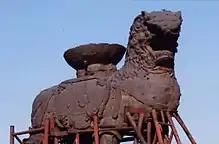
Jin, Northern, Southern dynasties and Three Kingdoms
After the invasions of northern nomadic peoples at the end of the Western Jin dynasty, the chaos of the Sixteen Kingdoms and the Northern and Southern dynasties ensued. Hebei, firmly in North China and right at the northern frontier, changed hands many times, being controlled at various points in history by the Later Zhao, Former Yan, Former Qin, and Later Yan. The Northern Wei reunified northern China in 440, but split in half in 534, with Hebei coming under the eastern half (first the Eastern Wei; then the Northern Qi), which had its capital at Ye (鄴), near modern Linzhang, Hebei. The Sui dynasty again unified China in 589.

Tang and Five dynasties
During the Tang dynasty (618–907), the area was formally designated "Hebei" (north of the Yellow River) for the first time. During the earlier part of the Five Dynasties and Ten Kingdoms period, Hebei was fragmented among several regimes, though it was eventually unified by Li Cunxu, who established the Later Tang (923–936). The next dynasty, the Later Jin under Shi Jingtang, posthumously known as Emperor Gaozu of Later Jin, ceded much of modern-day northern Hebei to the Khitan Liao dynasty in the north; this territory, called the Sixteen Prefectures of Yanyun, became a major weakness in the Chinese defense against the Khitans for the next century, since it lay within the Great Wall.
Song, Liao, Jin, and Yuan dynasties
During the Northern Song dynasty (960–1127), the sixteen ceded prefectures continued to be an area of hot contention between Song China and the Liao dynasty. The Southern Song dynasty that came after abandoned all of North China, including Hebei, to the Jurchen Jin dynasty after the Jingkang Incident in 1127 of the Jin–Song wars. Hebei was also heavily affected by the flooding of the Yellow River. Between 1048 and 1128, the river ran directly through the province rather than to its south.[21]
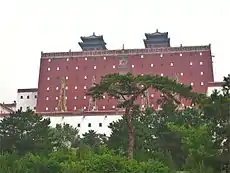
The Mongol Yuan dynasty divided China into provinces but did not establish Hebei as a province. Rather, the area was directly administrated by the Secretariat (中書省) at capital Dadu.
Ming and Qing dynasties
The Ming dynasty ruled Hebei as "Beizhili" (simplified Chinese: 北直隶; traditional Chinese: 北直隸; pinyin: Běizhílì), meaning "Northern Directly Ruled", because the area contained and was directly ruled by the imperial capital, Beijing; the "Northern" designation was used because there was a southern counterpart covering present-day Jiangsu and Anhui. When the Manchu Qing dynasty came to power in 1644, they abolished the southern counterpart, and Hebei became known as "Zhili", or simply "Directly Ruled". During the Qing dynasty, the northern borders of Zhili extended deep into what is now Inner Mongolia, and overlapped in jurisdiction with the leagues of Inner Mongolia.
Republic of China

The Qing dynasty collapsed in 1912 and was replaced by the Republic of China. Within a few years, China descended into civil war, with regional warlords vying for power. Since Zhili was so close to Peking (Beijing), the capital, it was the site of frequent wars, including the Zhiwan War, the First Zhifeng War and the Second Zhifeng War. With the success of the Northern Expedition, a successful campaign by the Kuomintang to end the rule of the warlords, the capital was moved from Peking (Beijing) to Nanking (Nanjing). As a result, the name of Zhili was changed to Hebei to reflect the fact that it had a standard provincial administration, and that the capital had been relocated elsewhere.
During the Second World War, Hebei was under the control of the Reorganized National Government of the Republic of China, a puppet state of Imperial Japan.
People's Republic of China
The founding of the People's Republic of China saw several changes: the region around Chengde, previously part of Rehe Province (historically part of Manchuria), and the region around Zhangjiakou, previously part of Chahar Province (historically part of Inner Mongolia), were merged into Hebei, extending its borders northwards beyond the Great Wall. Meanwhile, the city of Puyang was carved away, causing Hebei to lose access to the Yellow River. The city first became part of the short-lived Pingyuan Province, before eventually annexed into Henan.[22] The capital was also moved from Baoding to the upstart city of Shijiazhuang, and, for a short period, to Tianjin.
On July 28, 1976, Tangshan was struck by a powerful earthquake, the Tangshan earthquake, the deadliest of the 20th century with over 240,000 killed. A series of smaller earthquakes struck the city in the following decade.
Today, Hebei, along with Beijing and Tianjin municipalities which it enclaves, make up the Jing-Jin-Ji megalopolis region. With a population of 130 million, it is about six times the size as the New York metropolitan area and is one of the largest megalopolis cluster in China.[23] Beijing had also unloaded some of its non-capital functions to the province with the establishment of the Xiong'an New Area, which will further facilitate the integration of the three regions.[24]
Geography

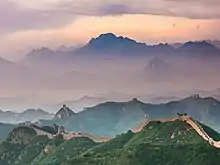
The geography of Hebei is quite diverse. It is the only province in China to contain plateaus, mountains, hills, shorelines, plains, and lakes.[25]
Most of central and southern Hebei lies within the North China Plain. The western part of Hebei rises into the Taihang Mountains (Taihang Shan), while the Yan Mountains (Yan Shan) run through northern Hebei, beyond which lie the grasslands of Inner Mongolia. The Great Wall of China cuts through northern Hebei from east to west as well, briefly entering the border of Beijing Municipality, and terminates at the seacoast of Shanhaiguan in northeastern Hebei. The highest peak is Mount Xiaowutai (小五台山) in Yu County in the northwest of the province, with an altitude of 2,882 m (9,455 ft).[1]
Hebei borders the Bohai Sea on the east. The Hai River watershed covers most of the province's central and southern parts, and the Luan River watershed covers the northeast. Not counting the numerous reservoirs to be found in Hebei's hills and mountains, the largest lake in Hebei is Baiyangdian, located mostly in Anxin County, Baoding.
Major cities in Hebei include:
- Shijiazhuang
- Baoding
- Tangshan
- Qinhuangdao
- Handan
- Zhangjiakou
Climate
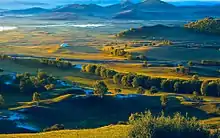
Hebei has a monsoon-influenced humid continental climate, with cold, dry winters, and hot, humid summers. Temperatures average −16 to −3 °C (3 to 27 °F) in January and 20 to 27 °C (68 to 81 °F) in July; the annual precipitation ranges from 400 to 800 mm (16 to 31 in), concentrated heavily in summer.
| City | July (°C) | July (°F) | January (°C) | January (°F) |
|---|---|---|---|---|
| Baoding | 31.7/22.6 | 89.1/72.7 | 2.5/–7.7 | 36.5/18.1 |
| Qinhuangdao | 28.1/21.7 | 82.6/71.1 | 0.1/–8.8 | 32.2/16.2 |
| Tangshan | 30.2/21.7 | 86.4/71.1 | 0.9/–10.2 | 33.6/13.6 |
| Zhangjiakou | 29.4/18.7 | 84.9/65.7 | 2.2/–12.9 | 36.0/8.8 |
Administrative divisions
Hebei is made up of eleven prefecture-level divisions: all prefecture-level cities:
| Administrative divisions of Hebei | ||||||||
|---|---|---|---|---|---|---|---|---|

Qinhuangdao
Handan
Xingtai
Baoding
Zhangjiakou
Chengde
Cangzhou
Langfang
↗
Hengshui
| ||||||||
| Division code[30] | Division | Area in km2[31] | Population 2010[32] | Seat | Divisions[33] | |||
| Districts | Counties | Aut. counties | CL cities | |||||
| 130000 | Hebei Province | 187700.00 | 71,854,202 | Shijiazhuang city | 49 | 91 | 6 | 21 |
| 130100 | Shijiazhuang city | 15848 | 9,547,869 | Chang'an District | 8 | 11 | 3 | |
| 130200 | Tangshan city | 14334.59 | 7,577,284 | Lunan District | 7 | 4 | 3 | |
| 130300 | Qinhuangdao city | 7791.57 | 2,987,605 | Haigang District | 4 | 2 | 1 | |
| 130400 | Handan city | 12066.00 | 9,174,679 | Congtai District | 6 | 11 | 1 | |
| 130500 | Xingtai city | 12433.00 | 7,104,114 | Xindu District | 4 | 12 | 2 | |
| 130600 | Baoding city | 22185.00 | 10,029,197 | Jingxiu District | 5 | 15 | 4 | |
| 130700 | Zhangjiakou city | 36861.55 | 4,345,491 | Qiaoxi District | 6 | 10 | ||
| 130800 | Chengde city | 39512.98 | 3,473,197 | Shuangqiao District | 3 | 4 | 3 | 1 |
| 130900 | Cangzhou city | 14305.28 | 7,134,053 | Yunhe District | 2 | 9 | 1 | 4 |
| 131000 | Langfang city | 6417.29 | 4,358,839 | Anci District | 2 | 5 | 1 | 2 |
| 131100 | Hengshui city | 8836.90 | 4,340,773 | Taocheng District | 2 | 8 | 1 | |
| Administrative divisions in Chinese and varieties of romanizations | ||||
|---|---|---|---|---|
| English | Chinese | Pinyin | ||
| Hebei Province | 河北省 | Héběi Shěng | ||
| Shijiazhuang city | 石家庄市 | Shíjiāzhuāng Shì | ||
| Tangshan city | 唐山市 | Tángshān Shì | ||
| Qinhuangdao city | 秦皇岛市 | Qínhuángdǎo Shì | ||
| Handan city | 邯郸市 | Hándān Shì | ||
| Xingtai city | 邢台市 | Xíngtái Shì | ||
| Baoding city | 保定市 | Bǎodìng Shì | ||
| Zhangjiakou city | 张家口市 | Zhāngjiākǒu Shì | ||
| Chengde city | 承德市 | Chéngdé Shì | ||
| Cangzhou city | 沧州市 | Cāngzhōu Shì | ||
| Langfang city | 廊坊市 | Lángfáng Shì | ||
| Hengshui city | 衡水市 | Héngshuǐ Shì | ||
These eleven prefecture-level divisions are subdivided into 168 county-level divisions (47 districts, 21 county-level cities, 94 counties and 6 autonomous counties). Those are, in turn, divided into 2207 township-level divisions (1 district public office, 937 towns, 979 townships, 55 ethnic townships, and 235 subdistricts). At the end of 2017, the total population of Hebei is 75.2 million.
Urban areas
| Population by urban areas of prefecture & county cities | |||||
|---|---|---|---|---|---|
| # | City | Urban area[34] | District area[34] | City proper[34] | Census date |
| 1 | Shijiazhuang[lower-alpha 1] | 2,770,344 | 2,834,942 | 10,163,788 | 2010-11-01 |
| (1) | Shijiazhuang (new districts)[lower-alpha 1] | 461,738 | 1,208,046 | see Shijiazhuang | 2010-11-01 |
| 2 | Tangshan[lower-alpha 2] | 2,128,191 | 3,187,171 | 7,577,289 | 2010-11-01 |
| (2) | Tangshan (new district)[lower-alpha 2] | 109,126 | 184,931 | see Tangshan | 2010-11-01 |
| 3 | Handan[lower-alpha 3] | 1,316,674 | 1,445,338 | 9,174,683 | 2010-11-01 |
| (3) | Handan (new districts)[lower-alpha 3] | 627,869 | 1,757,637 | see Handan | 2010-11-01 |
| 4 | Baoding[lower-alpha 4] | 1,038,195 | 1,138,521 | 11,194,382 | 2010-11-01 |
| (4) | Baoding (new districts)[lower-alpha 4] | 459,153 | 1,377,399 | see Baoding | 2010-11-01 |
| (4) | Baoding Xiong'an[lower-alpha 5] | 405,661 | 1,055,063 | see Baoding | 2010-11-01 |
| 5 | Qinhuangdao[lower-alpha 6] | 967,877 | 1,029,670 | 2,987,605 | 2010-11-01 |
| (5) | Qinhuangdao (new district)[lower-alpha 6] | 120,710 | 517,073 | see Qinhuangdao | 2010-11-01 |
| 6 | Zhangjiakou[lower-alpha 7] | 924,628 | 1,060,605 | 4,345,485 | 2010-11-01 |
| (6) | Zhangjiakou (new districts)[lower-alpha 7] | 209,414 | 591,334 | see Zhangjiakou | 2010-11-01 |
| 7 | Xingtai | 668,765 | 670,154 | 7,104,103 | 2010-11-01 |
| 8 | Chengde | 540,390 | 634,229 | 3,473,201 | 2010-11-01 |
| 9 | Langfang | 530,840 | 868,066 | 4,358,839 | 2010-11-01 |
| 10 | Cangzhou | 499,411 | 536,795 | 7,134,062 | 2010-11-01 |
| 11 | Dingzhou | 482,121 | 1,165,182 | see Baoding | 2010-11-01 |
| 12 | Renqiu | 430,896 | 822,455 | see Cangzhou | 2010-11-01 |
| 13 | Hengshui[lower-alpha 8] | 389,447 | 522,147 | 4,340,773 | 2010-11-01 |
| (13) | Hengshui (new district)[lower-alpha 8] | 165,363 | 362,013 | see Hengshui | 2010-11-01 |
| 14 | Sanhe | 386,902 | 652,042 | see Langfang | 2010-11-01 |
| 15 | Qian'an | 308,849 | 728,160 | see Tangshan | 2010-11-01 |
| 16 | Zunhua | 299,759 | 737,011 | see Tangshan | 2010-11-01 |
| 17 | Huanghua | 296,978 | 548,507 | see Cangzhou | 2010-11-01 |
| 18 | Wu'an | 293,151 | 819,000 | see Handan | 2010-11-01 |
| 19 | Bazhou | 291,710 | 622,975 | see Langfang | 2010-11-01 |
| 20 | Gaobeidian | 274,853 | 323,671 | see Baoding | 2010-11-01 |
| 21 | Zhuozhou | 260,493 | 303,125 | see Baoding | 2010-11-01 |
| 22 | Botou | 258,203 | 584,308 | see Cangzhou | 2010-11-01 |
| 23 | Hejian | 243,458 | 810,306 | see Cangzhou | 2010-11-01 |
| 24 | Xinji | 236,658 | 615,919 | see Shijiazhuang | 2010-11-01 |
| 25 | Shahe | 218,958 | 498,416 | see Xingtai | 2010-11-01 |
| (26) | Luanzhou[lower-alpha 9] | 208,212 | 554,315 | see Tangshan | 2010-11-01 |
| 27 | Shenzhou | 207,945 | 566,087 | see Hengshui | 2010-11-01 |
| 28 | Xinle | 194,480 | 487,652 | see Shijiazhuang | 2010-11-01 |
| 29 | Nangong | 188,260 | 469,030 | see Xingtai | 2010-11-01 |
| 30 | Jinzhou | 160,284 | 537,679 | see Shijiazhuang | 2010-11-01 |
| (31) | Pingquan[lower-alpha 10] | 136,401 | 229,622 | see Chengde | 2010-11-01 |
| 32 | Anguo | 135,524 | 185,386 | see Baoding | 2010-11-01 |
- New districts established after census: Gaocheng (Gaocheng CLC), Luquan (Luquan CLC). These new districts not included in the urban area & district area count of the pre-expanded city.
- New district established after census: Caofeidian (Tanghai County). The new district not included in the urban area & district area count of the pre-expanded city.
- New districts established after census: Yongnian (Yongnian County), Feixiang (Feixiang County); Handan County merged into Hanshan & Congtai. These new districts not included in the urban area & district area count of the pre-expanded city.
- New districts established after census: Mancheng (Mancheng County), Qingyuan (Qingyuan County), Xushui (Xushui County). These new districts not included in the urban area & district area count of the pre-expanded city.
- Xiong'an New Area is a special urban area jurisdiction consist of Rongcheng County, Anxin County, & Xiongxian County established after census.
- New district established after census: Funing (Funing County). The new district not included in the urban area & district area count of the pre-expanded city.
- New districts established after census: Wanquan (Wanquan County), Chongli (Chongli County); Xuanhua County merged into Xuanhua. These new districts not included in the urban area & district area count of the pre-expanded city.
- New district established after census: Jizhou (Jizhou CLC). The new district not included in the urban area & district area count of the pre-expanded city.
- Luanxian County is currently known as Luanzhou CLC after census.
- Pingquan County is currently known as Pingquan CLC after census.
Most populous cities in Hebei Source: China Urban Construction Statistical Yearbook 2018 Urban Population and Urban Temporary Population[35] | |||||||||
|---|---|---|---|---|---|---|---|---|---|
| Rank | Pop. | Rank | Pop. | ||||||
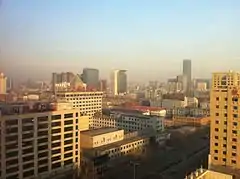 Shijiazhuang  Handan |
1 | Shijiazhuang | 2,843,100 | 11 | Chengde | 597,800 |  Tangshan  Baoding | ||
| 2 | Handan | 2,044,000 | 12 | Dingzhou | 416,100 | ||||
| 3 | Tangshan | 2,041,700 | 13 | Renqiu | 368,500 | ||||
| 4 | Baoding | 1,730,000 | 14 | Qian'an | 350,000 | ||||
| 5 | Qinhuangdao | 1,338,600 | 15 | Zhuozhou | 277,800 | ||||
| 6 | Zhangjiakou | 1,072,200 | 16 | Luanzhou | 273,000 | ||||
| 7 | Xingtai | 936,800 | 17 | Wu'an | 248,300 | ||||
| 8 | Cangzhou | 648,800 | 18 | Zunhua | 243,300 | ||||
| 9 | Hengshui | 643,400 | 19 | Sanhe | 218,700 | ||||
| 10 | Langfang | 608,400 | 20 | Xinji | 211,300 | ||||
Politics
The politics of Hebei is structured in a dual party-government system like all other governing institutions in mainland China.
The Governor of Hebei is the highest-ranking official in the People's Government of Hebei. However, in the province's dual party-government governing system, the Governor has less power than the Hebei Chinese Communist Party Provincial Committee Secretary (CCP Party Chief).
Economy

In 2014, Hebei's GDP was 2.942 trillion yuan (US$479 billion),[36] ranked 6th in the PRC, with its GDP per capita reaching 40,124 Renminbi. As of 2011, the primary, secondary, and tertiary sectors of industry contributed 203.46 billion, 877.74 billion, and 537.66 billion RMB respectively. The registered urban unemployment rate was 3.96%.

Hebei's industries include textiles, coal, steel, iron, engineering, chemical production, petroleum, power, ceramics and food.
40% of Hebei's labor force works in the agriculture, forestry and animal husbandry sectors, with the majority of production from these industries going to Beijing and Tianjin. Hebei's main agricultural products are cereal crops including wheat, maize, millet, and sorghum. Cash crops like cotton, peanut, soybeans and sesame are also produced.
Hebei's also abundant in natural resources. The Kailuan mine in Tangshan, with a history of over 100 years, is one of China's first modern coal mines, and remains a major mine with an annual production of over 20 million metric tonnes. Much of the North China Oilfied is found in Hebei, and there are also major iron mines at Handan and Qian'an. Iron, as well as steel, manufacturing are the largest industries in Hebei, and are likely to remain so as these industries consolidate and Hebei continues to grow as a manufacturing and transportation center for the region.
Economic and technological development zones
- Baoding Hi-Tech Industry Development Zone
- Langfang Export Processing Zone
- Qinhuangdao Economic & Technological Development Zone
- Qinhuangdao Export Processing Zone
- Shijiazhuang Hi-Tech Industrial Development Zone
- Xiong'an New Area
Demographics
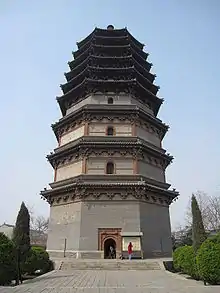
| Year | Pop. | ±% p.a. |
|---|---|---|
| 1912[37] | 26,658,000 | — |
| 1928[38] | 31,232,000 | +0.99% |
| 1936–37[39] | 28,644,000 | −1.08% |
| 1947[40] | 28,719,000 | +0.02% |
| 1954[41] | 35,984,644 | +3.27% |
| 1964[42] | 45,687,781 | +2.42% |
| 1982[43] | 53,005,876 | +0.83% |
| 1990[44] | 61,082,439 | +1.79% |
| 2000[45] | 66,684,419 | +0.88% |
| 2010[46] | 71,854,202 | +0.75% |
| 2020[47] | 74,610,235 | +0.38% |
| Hebei Province was known as Zhili Province until 1928. Beijing was part of Hebei Province[16] until 1928. Tainjin was part of Hebei Province until 1928 and 1954 to 1967. Rehe Province dissolved in 1955 and parts were incorporated into Hebei Province. Qahar Province dissolved in 1952 and parts were incorporated into Hebei Province. | ||
The population is mostly Han Chinese. 55 ethnic minorities are present in Hebei, representing 4.27% of the total population. The largest are Manchu (2.1 million people), Hui people (600000 people) and Mongol (180000 people).[48]
| Ethnic groups in Hebei, 2000 census | ||
|---|---|---|
| Nationality | Population | Percentage |
| Han Chinese | 63,781,603 | 95.65% |
| Manchu | 2,118,711 | 3.18% |
| Hui | 542,639 | 0.78% |
| Mongol | 169,887 | 0.26% |
| Zhuang | 20,832 | 0.031% |
It excludes members of the People's Liberation Army in active service.[49]
In 2004, the birth rate was 11.98 births per 1,000 people, while the death rate was 6.19 deaths per 1,000 people. In 2000 the sex ratio at birth was 118.46 males to 100 females.[50] In 2019, the birth rate was 10.83 births per 1,000 people, while the death rate was 6.12 deaths per 1,000 people.[51] The male population is 37,679,003(50.50%), the female population is 36,931,232(49.50%). The sex ratio of the total population was 102.02, decreasing 0.82 from 2010.[52]
Religion
The predominant religions in Hebei are Chinese folk religions, Taoist traditions and Chinese Buddhism. According to surveys conducted in 2007 and 2009, 5.52% of the population believe in and are involved in ancestor veneration, while 3.05% of the population identify as Christian,[53] mostly of the Catholic Church. Local worship of deities in the region began to organise into "benevolent churches" as a reaction to Catholicism in the Qing dynasty.
The reports didn't give figures for other types of religion; 90.61% of the population may be either irreligious or involved in worship of nature deities, Buddhism, Confucianism, Taoism and folk religious sects. Zailiism is a folk religious sect that originated in Hebei. There is a presence of Tibetan Buddhist schools in the province.
Hebei has the largest Catholic population in China, with 1 million members according to the local government.[55] and 1.5 million Catholics according to the Catholic Church.[56] The province is considered as the center of Catholicism in China. The town of Donglu in Baoding, where an apparition of the Virgin Mary was reported to have occurred in 1900, is reportedly "one of the strongholds of the unofficial Catholic Church in China".[57]
A large number of Catholics in Hebei remain loyal to the Pope and reject the authority of the Catholic Patriotic Church. Four of Hebei's underground bishops have been imprisoned in recent years: Bishop Francis An Shuxin of Donglu since 1996; Bishop James Su Zhimin since October 1997; and Bishops Han Dingxiang of Yongnian who died in prison in 2007 and Julius Jia Zhiguo of Zhengding since late 1999.[56][58] In 2003 there were 350.000 Protestants and 580.000 Muslims according to government statistics.[59][60] According to a survey, as of 2010 Muslims constitute 0.82% of the population of Hebei.[54]
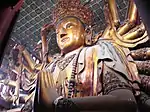
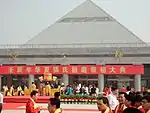
Culture
.jpg.webp)
Dialects of Mandarin are spoken over most of the province, and most Mandarin dialects in Hebei are in turn classified as part of the Ji Lu Mandarin subdivision. Regions along the western border with Shanxi, however, have dialects that are distinct enough for linguists to consider them as part of Jin, another subdivision of Chinese, rather than Mandarin. In general, the dialects of Hebei are quite similar to and readily intelligible with the Beijing dialect, which forms the basis for Standard Chinese, the official language of the nation. However, there are also some distinct differences, such as differences in the pronunciation of certain words that derive from entering tone syllables (syllables ending on a plosive) in Middle Chinese.[61]
Traditional forms of Chinese opera in Hebei include Pingju, Hebei Bangzi (also known as Hebei Clapper Opera), and Cangzhou Kuaiban Dagu. Pingju is especially popular: it tends to be colloquial in language and hence easy to understand for audiences. Originating from northeastern Hebei, Pingju has been influenced by other forms of Chinese opera like Beijing opera. Traditionally Pingju makes use of just a xiaosheng (young male lead), a xiaodan (young female lead), and a xiaohualian (young comic character), though it has since diversified with the use of other roles as well.[62]
_with_Peony%252C_Chrysanthemum%252C_and_Prunus_Sprays_LACMA_M.73.48.101.jpg.webp)
Quyang County, in central Hebei, is noted for Ding ware, a type of Chinese ceramics which includes various vessels such as bowls, plates, vases, and cups, as well as figurines. Ding ware is usually creamy white, though it is also made in other colors.
Hebei cuisine is typically based on wheat, mutton, and beans. The donkey burger, originating from the cities of Baoding and Hejian, Cangzhou in the central part of the province, is perhaps the most popular. A staple in the provincial cuisine, it has spread into the two municipalities as well. Other dishes include local variants of shaobing. The city of Baoding is also home to the Baoding balls, a kind of metal ball for exercise and meditation.
Notable individuals
As Han Yu described in Sending Off Dong Shaonan (送董邵南序), "The land of Yanzhao is said to be home of heroes with tragic fates since ancient times (燕赵古称多感慨悲歌之士)",[63] many famous warriors, generals, and politicals, both real and fictional, had hailed from Hebei:
- Qin Shi Huang (259 BC–210 BC)- Founder of the Qin dynasty and the first emperor of a unified China.
- Jing Ke (?–227 BC) - An assassin and retainer of Crown Prince Dan who attempted to murder Qin Shi Huang.
- Zhang Fei (?–221) - Military general during the late Eastern Han dynasty and early Three Kingdoms period who became sworn brothers with Liu Bei and Guan Yu.
- Zhao Yun or Zhao Zilong (?–229) - Military general who lived during the same period as Zhang Fei.
- Lin Chong - Also known as "Panther Head"; fictional character in Water Margin, one of the Four Great Classical Novels in Chinese literature.
- Wu Song - Nicknamed "Pilgrim"; also a famous character in Water Margin and famous for slaying a man-eating tiger.
- Liu Zhesheng (柳哲生, 1914–1991) - Ace-fighter pilot of Nationalist Air Force of China, veteran of the War of Resistance-WWII
Well-known people of other expertise include:
- Zu Chongzhi (429–500) - Astronomer, mathematician, politician, inventor, and writer who's known for calculating pi to an accuracy that won't be surpassed for 800 years.
- Feng Dao (881–954) - Confucian minister
- Yan Yuan (1635–1704) - Confucian philosopher
- Zhao Lirong (1928 – 2000) - Singer, film actress, and Ping opera performer.
- Xia Gengqi (1933 – ) - Curator in the Beijing Palace Museum.[64]
- Zheng Yuanjie (1955 – ) - Children's books author, and founder and sole writer of King of Fairy Tales (童话大王).
- Guo Jingjing (1981 – ) - Multi-time Olympic gold medalist and world champion who won the most Olympic medals of any female diver.
- Zanilia Zhao (1987 – ) - Actress who starred in multiple television series.
- Deng Lun (1992 – ) - Actor who gained popularity from the xianxia drama, Ashes of Love.
- Liu Shichao or Hebei Pangzai - Internet personality known for his food and drink stunts.
Media
Hebei is served by the province-wide Hebei Television, abbreviated HEBTV. It also covers parts of Beijing, Tianjin, Shandong, Henan, Shanxi, and Inner Mongolia. Shijiazhuang Radio & Television is a regional TV network that covers the provincial capital. Hebei is also served by three main newspapers, Hebei Daily, Yanzhao Metropolis Daily, and Yanzhao Evening News, all published by the Hebei Daily Newspaper Group.
Transportation
Because Hebei surrounds Beijing and Tianjin, all the numerous important railway lines radiating out of these two cities pass through Hebei. The Beijing–Guangzhou railway is one of the most important: it passes through many major cities such as Baoding, Shijiazhuang, Xingtai and Handan on its way south to Henan. Other important railways include the Beijing–Kowloon railway, Beijing–Shanghai railway, Beijing–Harbin railway, Beijing–Chengde railway, Beijing–Tongliao railway, Beijing–Baotou railway and Fengtai–Shacheng railway. High-speed rail lines crossing the province include the Beijing–Shanghai high-speed railway, Beijing–Guangzhou high-speed railway and Shijiazhuang–Taiyuan high-speed railway. Future high-speed rail lines from Beijing and Tianjin to Northeast China and Northwest China will traverse northern Hebei.
During the Eleventh Five-Year Plan, Beijing and Hebei were collaborating on a new passenger railway. The RMB 82.6 billion network will add 844 kilometers to the system. Current railway systems for Hebei trains are also being upgraded and will soon be able to travel at speeds of between 160 and 200 kilometers per hour.
As of the early 2013, railway schedule systems listed 160 passenger train stations within the province.[65]
The recent expressway boom in China has not left Hebei behind. There are expressways to every prefecture-level city of Hebei, totaling approximately 2,000 kilometers. The total length of highways within Hebei is around 40,000 kilometers.
There are a number of ports along the Bohai Sea, including Qinhuangdao (the second busiest in China with a capacity of over 100 million tons), Huanghua, and Jingtang. Shijiazhuang's Zhengding Airport is the province's center of air transportation, with domestic and international flights. Parts of Hebei are served by the Beijing Daxing International Airport in Beijing.[66]
The Shijiazhuang Metro is the only operational metro system in Hebei. Xiong'an Rail Transit is a planned metro system in Xiong'an.
Tourism
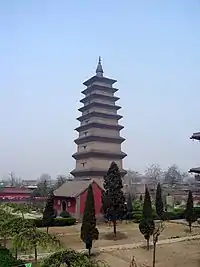
The Ming Great Wall crosses the northern part of Hebei and the eastern end is located on the coast at Shanhaiguan (Shanhai Pass), near Qinhuangdao. Informally known as the "First Pass of The World" (天下第一關), Shanhaiguan was the place where Ming general Wu Sangui opened the gates to Manchu forces in 1644, beginning nearly 300 years of Manchu rule; Shanhai Pass also marks the psychological entrance / exit of Manchuria, so that for centuries Manchuria was known as "outside the Pass" or "east of the Pass". Beidaihe, located near Shanhaiguan, is a popular beach resort well known as a former meeting place for top governmental officials.
The Chengde Mountain Resort and its outlying temples are a World Heritage Site. Also known as the Rehe Palace, this was the summer resort of the Manchu Qing dynasty emperors. The Chengde Resort was built between 1703 and 1792, and consists of a palace complex, a large park area composed of lakes, pavilions, causeways, bridges, etc., and a number of Tibetan Buddhist and Han Chinese temples in the surrounding area.
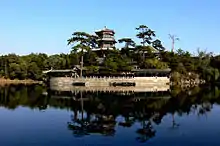
There are Qing dynasty imperial tombs at Zunhua (Eastern Qing Tombs) and Yixian (West Qing Tombs). The Eastern Qing Tombs are the resting place of 161 Qing emperors, empresses, and other members of the Qing imperial family, while the West Qing Tombs have 76. These are also part of a World Heritage Site.
The Zhaozhou, or Anji Bridge, built by Li Chun during the Sui dynasty, is the oldest stone arch bridge in China, and one of the most significant examples of pre-modern Chinese civil engineering.
Baoding, the old provincial capital, contains the historical Zhili Governor's Residence and the former court.
Xibaipo, a village about 90 km (56 mi) from Shijiazhuang, in Pingshan County was the location of the Central Committee of the Chinese Communist Party and the headquarters of the People's Liberation Army during the decisive stages of the Chinese Civil War between May 26, 1948, and March 23, 1949, at which point they were moved to Beijing. Today, the area houses a memorial site.[67]
Sports
The 2018 Women's Bandy World Championship was held in Hebei.
Sports teams based in Hebei include:
National Basketball League (China)
Hebei Springs Benma
Chinese Football Association
- Hebei F.C.
- Hebei Elite F.C.
- Cangzhou Mighty Lions F.C.
Education
Under the national Ministry of Education:
- North China Electric Power University (华北电力大学)
Under other national agencies:
- Central Institute for Correctional Police (中央司法警官学校)
- Chinese People's Armed Police Force Academy (中国人民武装警察部队学院)
- North China Institute of Science and Technology (华北科技学院)
Under the provincial government:
- Chengde Medical College (承德医学院)
- Handan College (邯郸学院)
- Hebei Agricultural University (河北农业大学)
- Hebei Engineering University (河北工程大学)
- Hebei Institute of Architecture and Civil Engineering (河北建筑工程学院)
- Hebei Medical University (河北医科大学)
- Hebei Normal University (河北师范大学)
- Hebei Normal University of Science and Technology (河北科技技师学院)
- Hebei North University (河北北方学院)
- Hebei Physical Educational Institute (河北体育学院)
- North China University of Science and Technology (华北理工大学)
- Hebei University (河北大学)
- Hebei University of Economics and Business (河北经贸大学)
- Hebei University of Technology (河北工业大学)
- Hebei University of Science and Technology (河北科技大学)
- Hengshui University (衡水学院)
- Langfang Teacher's College (廊坊师范学院)
- North China Coal Medical College (华北煤炭医学院)
- Shijiazhuang College (石家庄学院)
- Shijiazhuang Railway Institute (石家庄铁道学院)
- Shijiazhuang University of Economics (石家庄经济学院)
- Tangshan College (唐山学院)
- Tangshan Teacher's College (唐山师范学院)
- Xingtai University (邢台学院)
- Yanshan University (燕山大学)
Sister subdivisions
Hebei is twinned with the following country subdivisions:[68]
 Iowa (July 22, 1983)
Iowa (July 22, 1983) Nagano Prefecture (November 11, 1983)
Nagano Prefecture (November 11, 1983) Tottori Prefecture (June 9, 1986)
Tottori Prefecture (June 9, 1986) Veneto (May 17, 1988)
Veneto (May 17, 1988).svg.png.webp) East Flanders (October 4, 1991)
East Flanders (October 4, 1991) Leningrad Oblast (July 20, 1992)
Leningrad Oblast (July 20, 1992) Buenos Aires Province (May 19, 1992)
Buenos Aires Province (May 19, 1992) Missouri (January 25, 1994)
Missouri (January 25, 1994) South Chungcheong Province (October 19, 1994)
South Chungcheong Province (October 19, 1994) Hauts-de-Seine (February 11, 1997)
Hauts-de-Seine (February 11, 1997) Goiás (March 24, 1999)
Goiás (March 24, 1999) Athens (September 26, 2002)
Athens (September 26, 2002) Pest County (May 27, 2015)
Pest County (May 27, 2015)
See also
- Dongyi Protectorate
- Hebei People
- List of prisons in Hebei
- Major national historical and cultural sites in Hebei
Notes
- The data was collected by the Chinese General Social Survey (CGSS) of 2009 and by the Chinese Spiritual Life Survey (CSLS) of 2007, reported and assembled by Xiuhua Wang (2015)[53] in order to confront the proportion of people identifying with two similar social structures: ① Christian churches, and ② the traditional Chinese religion of the lineage (i.e. people believing and worshipping ancestral deities often organized into lineage "churches" and ancestral shrines). Data for other religions with a significant presence in China (deity cults, Buddhism, Taoism, folk religious sects, Islam, et al.) was not reported by Wang. The number of Muslims is taken from a survey reported in the year 2010.[54]
References
Citations
- Liu, Yanlin (2015). 太行山把最高的山脊留在了河北. Chinese National Geography (in Simplified Chinese) (2). Retrieved 20 May 2018.
小五台山是太行山主脉上的最高峰,同时也是河北省的最高峰
- "Communiqué of the Seventh National Population Census (No. 3)". National Bureau of Statistics of China. 11 May 2021. Retrieved 11 May 2021.
- GDP-2020 is a preliminary data "Home - Regional - Quarterly by Province" (Press release). China NBS. March 1, 2021. Retrieved March 23, 2021.
- "Sub-national HDI - Subnational HDI - Global Data Lab". globaldatalab.org. Retrieved 2020-04-17.
- Longman, J.C. (2008). Longman Pronunciation Dictionary (3rd ed.). Pearson Education ESL. ISBN 978-1405881173.
- "Hebei". Lexico UK English Dictionary. Oxford University Press. Archived from the original on May 18, 2021.
- "Hebei". Merriam-Webster Dictionary.
- "河北概况". 河北省人民政府. Archived from the original on 2020-08-13. Retrieved 2020-01-23.
- "河北省工业经济概况". 河北省工业和信息化厅. Archived from the original on 2020-01-21. Retrieved 2020-01-23.
- "河北钢铁工业概况". 中国铁合金网. Archived from the original on 2020-02-18. Retrieved 2020-01-23.
- "我国各省份名称的由来". 腾讯网. Retrieved 2021-01-10.
- Origin of the Names of China's Provinces Archived 2016-04-27 at the Wayback Machine, People's Daily Online.
- "Yellow bridge Chinese Dictionary". Yellow Bridge. Retrieved 15 April 2016.
- (in Chinese) Origin of the Names of China's Provinces Archived 2016-04-27 at the Wayback Machine, People's Daily Online.
- "河北省古称"燕赵之地",为什么现在的简称却是"冀"呢?". Sohu. Retrieved 2021-01-10.
- Chisholm, Hugh, ed. (1911). . Encyclopædia Britannica. Vol. 6 (11th ed.). Cambridge University Press. p. 133.
- "Yongle Emperor". World History Encyclopedia. Retrieved 2021-01-10.
- "直隶省的称呼延续了几百年,1928年,为何被改成了河北省?". 快资讯. Retrieved 2021-01-10.
- "New Archaeological Discoveries and Researches in 2004 – The Fourth Archaeology Forum of CASS". Institute of Archaeology, Chinese Academy of Social Sciences. Archived from the original on 2011-05-12. Retrieved 2007-09-18.
- "河北 - 中华名胜". 内地(祖国大陆)高校面向港澳台招生信息网. Retrieved 2021-01-10.
- Zhang, Ling (2016). The River, the Plain, and the State: An Environmental Drama in Northern Song China, 1048-1128. Cambridge: Cambridge University Press. pp. 1–4. ISBN 9781107155985.
- "濮阳地区一直属于河北省,1952年,为何划归给了河南省?". Sohu. Retrieved 2021-01-10.
- Johnson, Ian (July 19, 2015). "In China, a Supercity Rises Around Beijing". New York Times.
- Wong, Frank (March 16, 2019). "Xiong'an New Area: President Xi's Dream City". China Briefing.
- "全国唯一兼有高原、山地、丘陵、海滨、湖泊的省份". Sohu. Retrieved 2021-01-10.
- "Climate for Baoding". Weather China. Retrieved 10 June 2017.
- "Climate for Qinhuangdao". Weather China. Retrieved 10 June 2017.
- "Climate for Tangshan". Weather China. Retrieved 10 June 2017.
- "Climate for Zhangjiakou". Weather China. Retrieved 10 June 2017.
- 中华人民共和国县以上行政区划代码 (in Simplified Chinese). Ministry of Civil Affairs.
- Shenzhen Bureau of Statistics. 《深圳统计年鉴2014》 (in Simplified Chinese). China Statistics Print. Archived from the original on 2015-05-12. Retrieved 2015-05-29.
- Census Office of the State Council of the People's Republic of China; Population and Employment Statistics Division of the National Bureau of Statistics of the People's Republic of China (2012). 中国2010人口普查分乡、镇、街道资料 (1 ed.). Beijing: China Statistics Print. ISBN 978-7-5037-6660-2.
- Ministry of Civil Affairs (August 2014). 《中国民政统计年鉴2014》 (in Simplified Chinese). China Statistics Print. ISBN 978-7-5037-7130-9.
- 中国2010年人口普查分县资料. Compiled by 国务院人口普查办公室 [Department of Population Census of the State Council], 国家统计局人口和社会科技统计司编 [Department of Population and Social Science and Statistics, National Bureau of Statistics]. Beijing: China Statistics Print. 2012. ISBN 978-7-5037-6659-6.
{{cite book}}: CS1 maint: others (link) - Ministry of Housing and Urban-Rural Development of the People's Republic of China(MOHURD) (2019). 中国城市建设统计年鉴2018 [China Urban Construction Statistical Yearbook 2018] (in Chinese). Beijing: China Statistic Publishing House. Archived from the original on 2020-07-18. Retrieved 2021-11-29.
- "China's Provincial GDP Figures in 2011 – China Briefing News". 27 January 2012.
- 1912年中国人口. Retrieved 6 March 2014.
- 1928年中国人口. Retrieved 6 March 2014.
- 1936–37年中国人口. Retrieved 6 March 2014.
- 1947年全国人口. Retrieved 6 March 2014.
- 中华人民共和国国家统计局关于第一次全国人口调查登记结果的公报. National Bureau of Statistics of China. Archived from the original on 2009-08-05.
- 第二次全国人口普查结果的几项主要统计数字. National Bureau of Statistics of China. Archived from the original on 2012-09-14.
- 中华人民共和国国家统计局关于一九八二年人口普查主要数字的公报. National Bureau of Statistics of China. Archived from the original on 2012-05-10.
- 中华人民共和国国家统计局关于一九九〇年人口普查主要数据的公报. National Bureau of Statistics of China. Archived from the original on 2012-06-19.
- 现将2000年第五次全国人口普查快速汇总的人口地区分布数据公布如下. National Bureau of Statistics of China. Archived from the original on 2012-08-29.
- "Communiqué of the National Bureau of Statistics of People's Republic of China on Major Figures of the 2010 Population Census". National Bureau of Statistics of China. Archived from the original on 2013-07-27.
- "河北省第七次全国人口普查公报(第一号)" (PDF). Hebei Provincial Bureau of Statistics. Retrieved 2021-07-10.
- 河北省少数民族及宗教概况. Hebei People's Government. Archived from the original on 2017-04-19. Retrieved 2014-08-28.
- {{Source: Department of Population, Social, Science and Technology Statistics of the National Bureau of Statistics of China and Department of Economic Development of the State Ethnic Affairs Commission of China, eds. Tabulation on Nationalities of 2000 Population Census of China. 2 vols. Beijing: Nationalities Publishing House (民族出版社), 2003. (ISBN 7-105-05425-5)}}
- "Gender Gaps in China: Facts and Figures" (PDF). World Bank. p. 4. Retrieved 2016-08-05.
- "分省年度数据". National Bureau of Statistics of China. Retrieved 2021-07-10.
- "河北省第七次全国人口普查公报(第三号)" (PDF). Hebei Provincial Bureau of Statistics. Retrieved 2021-07-10.
- China General Social Survey 2009, Chinese Spiritual Life Survey (CSLS) 2007. Report by: Xiuhua Wang (2015, p. 15) Archived 2015-09-25 at the Wayback Machine
- Min Junqing. The Present Situation and Characteristics of Contemporary Islam in China. JISMOR, 8. 2010 Islam by province, page 29. Data from: Yang Zongde, Study on Current Muslim Population in China, Jinan Muslim, 2, 2010.
- 天主教. hebmzt.gov.cn. Archived from the original on 2017-09-22. Retrieved 2014-08-26.
- 河北地下教会主教成为爱国会成员. chinacath.org. 2010-09-15. Archived from the original on 2014-09-03. Retrieved 2014-08-27.
- Country Advice China, Australian Government 13 February 2012
- Hebei Archived 2015-09-24 at the Wayback Machine, Pray for China
- 基督教. www.hebmzt.gov.cn. Archived from the original on 2016-11-10. Retrieved 2014-08-26.
- 伊斯兰教. www.hebmzt.gov.cn. Archived from the original on 2016-04-21. Retrieved 2014-08-26.
- "你永远猜不出一个河北人的真实身份". Zhihu. Retrieved 2021-01-10.
- "评剧、河北梆子". 中华传统文化数字资源库系统. Retrieved 2021-01-10.
- Han, Yu. "古诗文网" 送董邵南序 (in Simplified Chinese). Retrieved 2020-01-14.
- Xue, Li (19 July 2010). 杂项专家夏更起:全国有十几家拍卖公司足矣(图). Beijing Business Daily (in Simplified Chinese). Retrieved 1 January 2011.
- List of train stations in Hebei (in Chinese)
- Moore, Malcolm (September 9, 2011). "China to build world's biggest airport". The Daily Telegraph.
- Kenneth Pomeranz (July 22, 2010), Musings on a Museum: A Trip to Xibaipo
- 河北省地级市及部分县级市缔结国际友好城市列表. Xinhua Hebei (in Chinese (China)). 2006-04-13. Archived from the original on 2015-09-24. Retrieved 2020-02-06.
